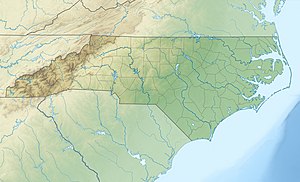Alligator River (North Carolina)
| Alligator River Tributary to Albemarle Sound | |
|---|---|
 | |
 Location of Alligator River mouth | |
| Location | |
| Country | United States |
| State | North Carolina |
| Counties | Dare Hyde Tyrell |
| Physical characteristics | |
| Source | divide between Pungo River, Lake Mattamuskeet and Alligator River |
| • location | about 3 miles NW of Fairfield, North Carolina[2] |
| • coordinates | 35°33′59″N 075°58′54″W / 35.56639°N 75.98167°W[1] |
| • elevation | 2 ft (0.61 m)[3] |
| Mouth | Albemarle Sound |
• location | East Lake, North Carolina[2] |
• coordinates | 35°58′02″N 075°58′54″W / 35.96722°N 75.98167°WCoordinates: 35°58′02″N 075°58′54″W / 35.96722°N 75.98167°W[1] |
• elevation | 0 ft (0 m)[3] |
| Length | 47.37 mi (76.23 km)[4] |
| Basin size | 571.24 square miles (1,479.5 km2)[5] |
| Discharge | |
| • location | Albemarle Sound |
| • average | 619.03 cu ft/s (17.529 m3/s) at mouth with Albemarle Sound[6] |
| Basin features | |
| Progression | North |
| River system | Albemarle Sound |
| Tributaries | |
| • left | New Lake Fork Northwest Fork Gum Neck Creek Goose Creek Second Creek Little Alligator River |
| • right | Swan Creek Whipping Creek Milltail Creek |
Alligator River is a small river in eastern North Carolina, separating Dare County and Tyrrell County. It empties into Albemarle Sound. A 21-mile canal connects the Alligator River with Pungo River to its west. The Lindsey C. Warren Bridge of U.S. Route 64 crosses the river.
Alligator River is protected as part of Alligator River National Wildlife Refuge. Habitat bordering the Refuge includes many diverse types including high and low pocosin,[7] bogs, fresh and brackish water marshes, hardwood swamps, and Atlantic white cypress swamps. Plant species include pitcher plants and sun dews, low bush cranberries, redbay, Atlantic white cypress, pond pine, American sweetgum, red maple, and a wide variety of herbaceous and shrub species common to the East Coast.
The refuge is one of the premier strongholds for American black bear[8] on the Eastern Seaboard. It also has concentrations of ducks, geese, and swans. The wildlife diversity includes wading birds, shorebirds, American woodcock, raptors, black bears, alligators, white-tailed deer, raccoons, cottontail rabbits, bobwhite quail, northern river otters, red wolves,[9][10] red-cockaded woodpeckers,[11] and neotropical migrants.
References[]
- ^ a b "GNIS Detail - Alligator River". geonames.usgs.gov. US Geological Survey. Retrieved 23 July 2019.
- ^ a b "Alligator River Topo Map, Tyrrell County NC (East Lake Area)". TopoZone. Locality, LLC. Retrieved 23 July 2019.
- ^ a b "Alligator River National Wildlife Refuge Topo Map, Dare County NC (East Lake SE Area)". TopoZone. Locality, LLC. Retrieved 31 July 2019.
- ^ "ArcGIS Web Application". epa.maps.arcgis.com. US EPA. Retrieved 23 July 2019.
- ^ "Alligator River Watershed Report". Waters Geoviewer. US EPA. Retrieved 31 July 2019.
- ^ "Alligator River Watershed Report". Waters Geoviewer. US EPA. Retrieved 23 July 2019.
- ^ "Alligator River National Wildlife Refuge". Outer Bank News. Archived from the original on 2006-06-13. Retrieved 2006-06-11.
- ^ "Draft Comprehensive Conservation Plan and Environmental Assessment comments due by June 29, 2006". U.S. Fish and Wildlife Service. Archived from the original on 30 June 2006. Retrieved 2006-06-11.
- ^ "Red Wolf Recovery Project". Archived from the original on 3 July 2006. Retrieved 2006-06-11.
- ^ "Alligator River National Wildlife Refuge Red Wolf Re-establishment Program". Outer Banks News. Archived from the original on 16 June 2006. Retrieved 11 June 2006.
- ^ "Alligator River National Wildlife Refuge". Trails.com. Archived from the original on 1 June 2006. Retrieved 11 June 2006.
External links[]
- U.S. Geological Survey Geographic Names Information System: Alligator River
- http://www.fws.gov/alligatorriver/
- Rivers of North Carolina
- Rivers of Dare County, North Carolina
- Rivers of Tyrrell County, North Carolina
- Tributaries of Albemarle Sound
- Eastern North Carolina geography stubs
- North Carolina geography stubs
- Southern United States protected area stubs
- North Carolina river stubs
